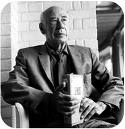Henry Valentine Miller 1891 – 1980
November 27, 2008
 Henry Valentine Miller 1891
– 1980 was an American writer and painter.
Henry Valentine Miller 1891
– 1980 was an American writer and painter.
Miller knew homeopath Rene Felix Eugene Allendy and was profoundly impressed by him. Rene Felix Eugene Allendy was the psychoanalyst of Anaïs Nin.
Miller wrote about homeopathy in his novels Moloch and Sexus, and in his book Hamlet’s Letters.
Miller was born to tailor Heinrich Miller and Louise Marie Neiting, in the Yorkville section of Manhattan, New York City, of German Catholic heritage. As a child he lived at 662 Driggs Avenue in Williamsburg, Brooklyn, known in that time (and referred to frequently in his works) as The Fourteenth Ward.
As a young man, he was active with the Socialist Party (his “quondam idol” was the Black Socialist Hubert Harrison). He briefly - for only two months - attended the City College of New York. Although he was an exceptional scholar, he could neither be anchored nor submit to the traditional college system of education.
In both 1928 and 1929, he spent several months in Paris with his second wife, June Edith Smith (June Miller) (his first wife was Beatrice Sylvas Wickens, whom he married in 1917).
The next year he moved to Paris unaccompanied, and he continued to live there until the outbreak of World War II. He lived an impecunious lifestyle that depended on the benevolence of friends, such as Anaïs Nin, who became his lover and financed the first printing of Tropic of Cancer in 1934.
In the fall of 1931, Miller got a job with the Chicago Tribune (Paris edition) as a proofreader, thanks to his friend Alfred Perles who worked there. Miller took this opportunity to submit some of his own articles under Alfred Perles name, since only the editorial staff were permitted to publish in the paper in 1934.
This period in Paris was highly creative for Miller, and during this time he also established a significant and influential network of authors circulating around the Villa Seurat. During this period he was also influenced by the French Surrealists.
His works contain detailed accounts of sexual experiences, and his books did much to free the discussion of sexual subjects in American writing from both legal and social restrictions.
He continued to write novels that were banned in the United States on grounds of obscenity. Along with Tropic of Cancer, his Black Spring (1936) and Tropic of Capricorn (1939) were smuggled into his native country, building Miller an underground reputation.
One of the first acknowledgments of Henry Miller as a major modern writer was by George Orwell in his 1940 essay Inside the Whale, where he wrote:
“Here in my opinion is the only imaginative prose-writer of the slightest value who has appeared among the English speaking races for some years past. Even if that is objected to as an overstatement, it will probably be admitted that Miller is a writer out of the ordinary, worth more than a single glance; and after all, he is a completely negative, unconstructive, amoral writer, a mere Jonah, a passive acceptor of evil, a sort of Whitman among the corpses.”
In 1940, he returned to the United States, settling in Big Sur, California, and continued to produce his vividly written works that challenged contemporary American cultural values and moral attitudes. He spent the last years of his life in Pacific Palisades, Los Angeles, California.
While Miller was establishing his base in Big Sur, the ‘Tropics’ books, still banned in the USA, were being published in France. There they were acquiring a slow and steady notoriety among both Europeans and the various enclaves of American cultural exiles.
As a result, the books were frequently smuggled into the States, where they would prove to be a major influence on the new Beat generation of American writers (most notably Jack Kerouac) some of whom would adopt stylistic and thematic principles found in Miller’s oeuvre.
The publication of Miller’s Tropic of Cancer in the United States in 1961 led to a series of obscenity trials that tested American laws on pornography. The U.S. Supreme Court, in Grove Press, Inc., v. Gerstein, citing Jacobellis v. Ohio (which was decided the same day in 1964), overruled the state court findings of obscenity and declared the book a work of literature; it was one of the notable events in what has come to be known as the sexual revolution.
Elmer Gertz, the lawyer who successfully argued the initial case for the novel’s publication in Illinois, became a lifelong friend of Miller’s. Volumes of their correspondence have been published.
In addition to his literary abilities, Miller was a painter and wrote books about his painting. He was a close friend of the French painter Grégoire Michonze. He was also an amateur pianist.
Before his death, Miller filmed with Warren Beatty for his film Reds. He spoke of his remembrances of John Reed and Louise Bryant as part of a series of cameos or witnesses. The film was released a year and a half after Miller’s death.
Miller died in Pacific Palisades. After his death, he was cremated and his ashes scattered off Big Sur.
Miller’s papers were donated to the UCLA Young Research Library Department of Special Collections. The Henry Miller Art Museum at Coast Gallery in Big Sur, the Harry Ransom Humanities Research Center at the University of Texas at Austin, and UCLA all hold a selection of Miller’s watercolors, as did The Henry Miller Museum of Art in Omachi City in Nagano, Japan, before closing in 2003.
A portion of the correspondence between the Grove Press and Henry Miller are currently housed in the Special Collections Research Center at Syracuse University. Special Collections at the University of Victoria holds a significant collection of Miller’s manuscripts and correspondences, including the corrected typescript for Max and Quiet Days in Clichy, as well as Miller’s lengthy correspondence with Alfred Perlès.